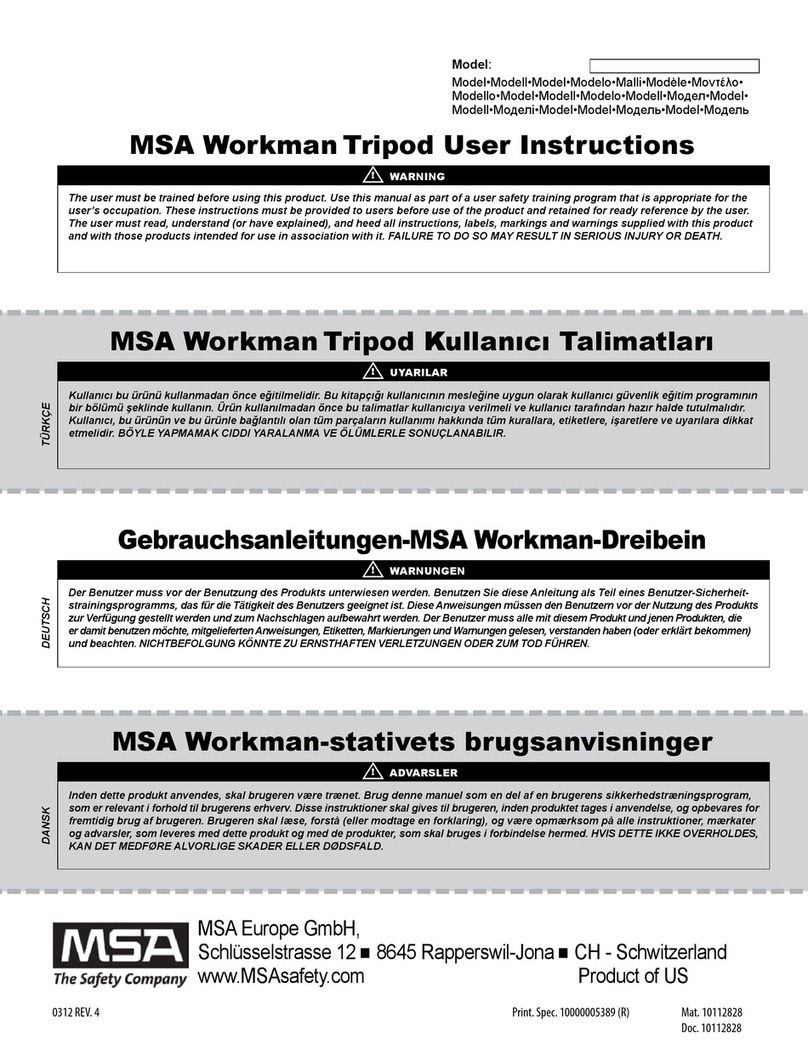
MSA Workman® Tripod 5
US
1.4 Safety and Precautionary Measures to be Adopted
WARNING!
DO NOT exceed the allowable free fall distance or exceed the maximum fall arrest forces as spec-
ified by governing standards or subsystem components.
The anchorage to which the MSA Workman Tripod is attached must be rated in the direction of
intended use. See sections 2.1.4 "Anchorages and Anchorage Connectors" and 3 "Use" for details
on anchorage strength and loading details.
When installing or removing the MSA Workman Tripod limit exposure to fall hazards. A separate
independent fall arrest system may be required.
Ensure that fall clearance is sufficient to meet governing standards or subsystem component
requirements.
Prevent swing falls and impact with objects in or adjacent to the fall path. Always remove obstruc-
tions below the work area to ensure a clear fall path. Keep work area free from debris, obstruc-
tions, trip hazards, spills or other hazard which could impair the safe operation of the fall protection
system. DO NOT use the MSA Workman Tripod unless a qualified person has inspected the work-
place and determined that identified hazards can neither be eliminated nor exposures to them
prevented.
Work directly under the anchorage connector at all times. A full body harness is the only accept-
able body holding device that can be used in a fall arrest system.
DO NOT rely on feel or sound to verify proper snaphook or carabiner engagement. Ensure that
gate and keeper are closed before use.
If the MSA Workman Tripod is damaged or is subjected to fall arrest forces or impact forces, it must
be immediately removed from service and marked as "UNUSABLE" until it has been destroyed.
DO NOT leave the MSA Workman Tripod installed in environments which could cause damage or
deterioration to the product. Refer to sections 4 "Care, Maintenance and Storage" and 5 "Inspec-
tion" for care and inspection details. Do not leave unattended loads on the MSA Workman Tripod.
DO NOT use where lanyard or shock absorber may be exposed to sharp or abrasive edges or
sheared, expanded metal, or frame cut steel. Sharp edges may cut a lanyard or shock absorber
during a fall. Cover all sharp or abrasive edges with padding or sheathing before working above
edge.
Chemical hazards, heat and corrosion may damage the MSA Workman Tripod. More frequent
inspections are required in these environments.
DO NOT use the MSA Workman Tripod adjacent to moving machinery, electrical hazards, or in
the presence of excessive heat, open flame or molten metal.
DO NOT use fall arrest or rescue equipment in environments with temperatures greater than
130°F (34°C) or temperatures lower than -30°F (-34°C).
DO NOT use the MSA Workman Tripod near energized equipment or where contact with high
voltage power lines may occur. The metal components may provide a path for electrical current to
flow, resulting in an electrical shock or electrocution.
Remove any surface contamination such as, but not limited to, concrete, stucco, roofing material,
etc that could accelerate cutting or abrading of attached components.
MSA Workman Tripods are to be designated and used solely for approved applications.
Unauthorized alterations, relocations, or additions to the anchorage connector extension are not
permitted.
DO NOT alter this equipment or intentionally misuse it. DO NOT use fall protection equipment for
purposes other than those for which it was designed.





























